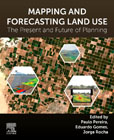
Mapping and Forecasting Land Use: The Present and Future of Planning
Pereira, Paulo
Gomes, Eduardo
Rocha, Jorge
Mapping and Forecasting Land Use: The Present and Future of Planning is a comprehensive reference on the use of technologies to map land use, focusing on GIS and remote sensing applications and methodologies for land use monitoring. The book addresses transversal topics such as urbanization, biodiversity loss, climate change, ecosystem services, and participatory planning, with pros and cons of a variety of aerial technologies in mapping and land use. The book has specifically been developed with a multidisciplinary approach in mind and provides opinions and evidence from leading researchers working in academic institutions across the globe. The second half of the book moves from theory and research advancement into case studies, compiling global examples to provide real-world context and evidence of the techniques and applications.Mapping and Forecasting Land Use: The Present and Future of Planning is a useful guide for graduates, academics and researchers in the fields of geography, geographic information science and land use science, who want to effectively apply GIS and remote sensing capabilities to mapping or wider land studies. Researchers in Geosciences, Environmental Science and Agriculture will also find this of value in utilizing 21st century technologies to their field. Provides a guide to land use mapping technologies including GIS and remote sensing Covers a wide field of interdisciplinary subjects related to GIS applications in land use Approaches the theory and current research in the first half of the book, then focuses on global case studies in the second half INDICE: 1. Introduction Section 1: Theory 2. Land-use changes and Ecosystem Services 3. Future land use/cover changes and participatory planning 4. Earth observation, Land-Use and Land-Cover Mapping and Society 5. Peri-urban land use 6. Advancing land-use modelling requires new data to understand and represent human decision making 7. Forecasting Land-use and land cover change: opening stakeholders' black box 8. Landscape, water, people and climate 9. Drivers of land use changes in Latin America. A review focusing on irrigated drylands Section 2: Case Studies 10. Land use dynamics on the Tibetan Plateau 11. Cultivation spread into desert land over the last five decades (1972-2020), challenges and choices. A case study surrounding areas of Nile delta 12. Land use management for coastal flooding prevention; a participatory simulation platform applied to Camargue (France) 13. The role of non-farm activities in the transformation of peri-urban landscapes from agricultural to urban landscapes (Greater Copenhagen, Denmark) 14. Setting up a Land Use Cover Change Model for Greater Sydney. Lessons learnt and challenges ahead 15. Land-use change in the touristic city (Lisbon, Portugal) 16. Land use change effects in one UNESCO cultural landscape and future projection (Viñales, Cuba) 17. Projections of future land use changes and associated ecosystem services loss in Kolkata megacity region
- ISBN: 978-0-323-90947-1
- Editorial: Elsevier
- Encuadernacion: Rústica
- Páginas: 400
- Fecha Publicación: 01/08/2022
- Nº Volúmenes: 1
- Idioma: Inglés
